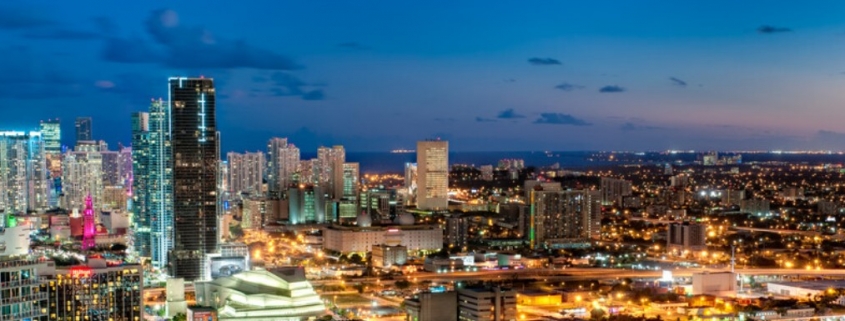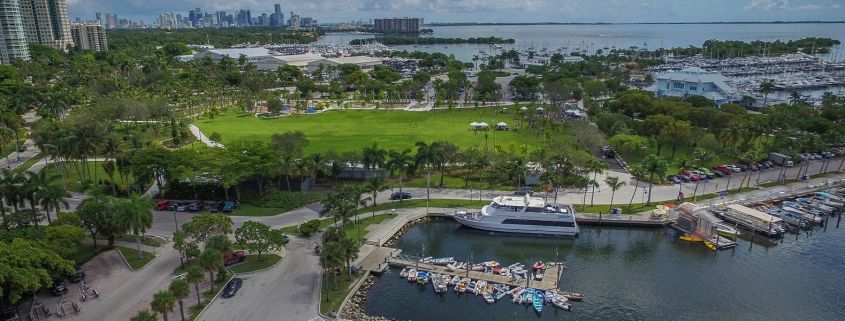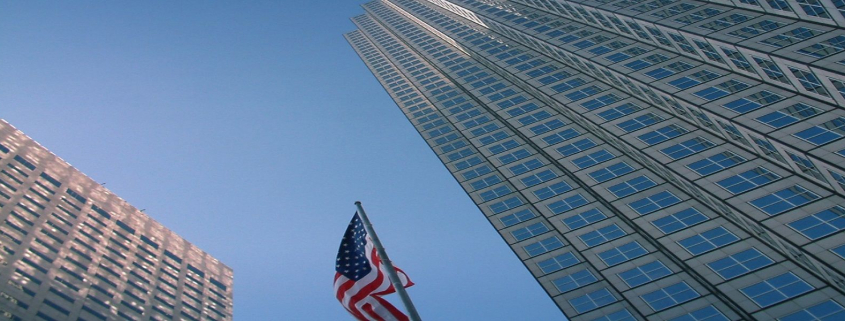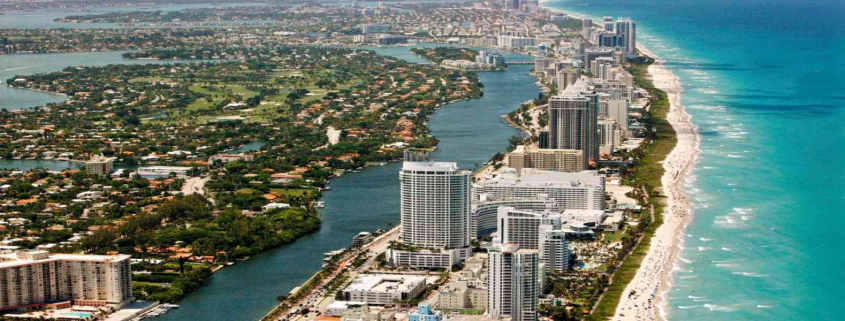Brokers are particularly seeing buyers from Brazil, Argentina and Colombia.
Posts
Foreign investment in the U.S. may have slowed down during the coronavirus pandemic, but it didn’t disappear, and it’s been growing since international travel picked up, Miami real estate experts say.
Coconut Grove is seeing boom times. How long will it last?
Oscar Rodriguez, principal of ROVR Development to get his insights on this market. ROVR is developing only new waterfront project rising in Coconut Grove—The Fairchild Coconut Grove.
GlobeSt.com: What are some of the main factors driving the recent boom in Coconut Grove?
Rodriguez: Coconut Grove has it all, from lushly landscaped quiet neighborhoods and architectural charm to a dynamic cultural, dining and entertainment destination and an active beautiful waterfront on Miami’s Biscayne Bay. All of this is within close proximity to Miami’s business and financial core, making Coconut Grove an ideal place to call home.
The community has so much to offer: beautiful parks, close proximity to the best schools including Gulliver Academy, Ransom Everglades School, Carrollton School of the Sacred Heart and The University of Miami, green canopied neighborhoods and amenity driven shopping and dining centers such as The Mayfair and Cocowalk. Coconut Grove is central to everything and has a hip vibe that can’t be replicated.
GlobeSt.com: What is your forecast for the market in Coconut Grove for 2018?
Rodriguez: Coconut Grove has always had a unique heart and soul that will continue to be the source of its popularity and success. The area has attracted high profile residents and has developed exponentially in the past few years. Local and international demand for this one of a kind community will continue to propel Coconut Grove as one of the strongest markets in South Florida.
As more and more people are drawn to the area and discover its untapped potential, it will continue to grow and progress. But I believe it will always hold on to that unique vibe that makes it special and preserve that neighborhood feel.
Source: GlobeSt.
What’s ahead in 2018 on the condo front? Is there a sweet spot in the market? What about Chinese buyers?
GlobeSt.com caught up with Art Falcone, co-founder and managing principal of Encore, to get his thoughts in part one of this exclusive interview series.
GlobeSt.com: You recently sold out your luxury condo project on Fort Lauderdale Beach. Do you expect sales momentum for luxury condos in South Florida to continue in 2018 or will there be a slowdown?
Falcone: We could potentially see a slowdown because of lenders, not a lack of buyers. The slowdown on luxury condos started about two years ago, and because of that, lenders have pulled back dramatically on financing new condo projects. That’s ultimately causing problems for developers and resulting in an additional slowdown.
GlobeSt.com: Is there a sweet spot in the condo market right now?
Falcone: The sweet spot is in amenity-rich developments. That includes both the actual buildings and the surrounding communities. Our Miami Worldcenter project is in the middle of Downtown Miami where people can live, work and play.
They have the best shopping and restaurants plus museums, the performing arts center and sporting games and arenas. Everything is walkable. If you’re under $800 per square foot in a great, amenity-rich area, that’s the sweet spot.
GlobeSt.com: Chinese buyers have been active at Paramount Miami Worldcenter. Do you see an influx of Chinese buyers coming to Miami in the year ahead?
Falcone: The reason we’ve seen so many Chinese buyers at Paramount Miami Worldcenter is because we’ve actively sought them out by going to China every month. That being said, right now both Orlando and Miami International airports are considering adding non-stop flights to China. If that happens, there will definitely be an influx of Chinese buyers.
Source: GlobeSt.
Brazil is to the Miami real estate market as LeBron James was to the Miami Heat: a supernova phenomenon that lifted us to the greatest heights, but left difficult questions and painful longing in its absence.
And as the former MVP teased a dramatic comeback to the Magic City on his Instagram in July, Brazil appears doing the same.
In 2010, Brazilians rescued Miami from the biggest housing bubble this country has seen. They arrived on our shores and purchased troves of stagnant and deeply discounted real estate all the way from Doral to Miami’s beaches, at all price levels. It was like a tidal wave of cash that quickly soaked up a huge surplus of inventory, which some experts predicted would take a decade to completely sell out.
But it only took two years for Miami real estate to recover like nothing ever happened; much like it took James two years to bring Miami its NBA championship. It was the start of a new real estate boom that brought Miami renewed global attention.
(While many other countries participated in this spectacular surge, Brazil’s sheer size had the most impact of all. According to the CIA’s World Factbook, it is the fifth-largest country in the world; with more than 207 million people, the sixth-most populous; and it claims the world’s eighth-largest economy.)
Miami being Miami, where we build and sell real estate better than anywhere else, it quickly sold out that entire older supply of inventory, and then moved on to build thousands of new apartments and homes. It’s what we do. And we felt the pain of Brazil’s downfall as sharply as the Heat felt LeBron’s heartbreaking departure.
The Fall
According to the World Bank Group’s June 2017 report “Global Economic Prospects: A Fragile Recovery,” Brazil’s real Growth Domestic Product significantly declined in 2015, by as much as 3.8 percent. The effects were felt immediately in Miami with a sudden and steady decline in the number of Brazilian real estate buyers.
The numbers were not much better in 2016, when the GDP fell again, this time by an additional 3.3 percent. The country’s unemployment rates outpaced most other Latin American countries in that same year.
“In Brazil, rising unemployment, tightening financial conditions and continued political tensions extended deep declines in private consumption and investment,” the report adds.
Brazil was neck-deep in trouble, both politically and economically. It did not help that, as the United States emerged from the Great Recession and the dollar gained significant strength, the Brazilian real took a dive and the exchange rate between the two currencies went from two Brazilian reals for one dollar to a whopping four Brazilian reals in 2016. It was devastating — imagine that condo on the ocean you might be considering for $2 million suddenly doubling in price.
The Rise
After much turmoil and soul-searching, Brazil’s economy is finally showing signs of life. Its GDP is up 0.5 percent this year, and that number is expected to accelerate to 1.8 percent in 2018 and 2.12 in 2019, according to the World Bank Group report. And right on cue, wealthy Brazilian buyers have once again renewed their love affair with Miami real estate.
The Porsche Design Tower and Residences by Armani Casa in Sunny Isles Beach, are experiencing a remarkable new surge of buyers from Brazil.
Another indication of confidence in Brazil’s improving economy, as well as its love affair with Miami, was Avianca Brasil’s recent launch of direct flights between Sao Paolo and Miami.
That company’s president was quoted in Forbes saying, “…it’s still not clear how fast the recovery will come…but at the same time Brazil is a very big country with huge potential.”
There’s an important distinction with this year’s crop of Brazilian buyers. Those who made their investments earlier in the decade were buying in Miami just to get some of their money out of the country, and to have a pied-à-terre where they could spend the holidays and shop.
Many of these buyers are looking to permanently leave their country, as they are fed up with not only the economic and political climate, but also the lack of safety and stability. They are looking to move here permanently, and also buying businesses such as restaurants, stores, shopping centers and income-generating properties. They have little faith in their home country, and are looking to build new lives in America.
The Future?
Just as the Heat did not collapse when James returned to Cleveland, Brazilian buyers never truly stopped investing in Miami altogether. Even at its lowest point, the country has remained a staple on the monthly Miami Association of Realtors list of foreign countries that search for local real estate online.
Whether Brazil can reclaim and hold the top spot for a sustained period remains to be seen, but the hope here is that the country cleans up its act politically, maintains and improves its economic stability, and becomes a steady and more predictable source of investment in Miami real estate.
Source: Miami Herald
The Little Haiti area will be South Florida’s hottest residential neighborhood in 2017, even as the wider region cools down, according to a recent report released by real estate website Zillow.
The company predicts home values in the gentrifying area north of downtown Miami will rise 4.6 percent this year. (Zillow included Little River, Buena Vista and the area around the Design District — together once known as Lemon City — in its analysis.) That’s the fastest rate in Miami-Dade, Broward and Palm Beach counties. But South Florida as a whole will grow at a 1.6 percent clip, Zillow said. Miami’s growth rate puts it at number 90 of the country’s 96 largest metro areas, according to Zillow projections.
Little Haiti, ‘The Next Wynwood’
With Brickell and the Beach overbuilt, developers are now zeroing in on under-valued neighborhoods close to the urban core.
“This could be the next Wynwood” is the mantra of many investors and home flippers crowding into Little Haiti. The average home there is valued at $191,500, up 19.6 percent over the last year, according to Zillow.
Just south of the booming neighborhood, the Archdiocese of Miami wants to sell the 15-acre campus of Archbishop Curley-Notre Dame High School in Buena Vista. Developers have also unveiled plans for large, mixed-use projects. And restaurants and commercial business are moving in, too, most recently Entercom Communications, one of the country’s biggest radio broadcasters, which signed a lease in Little River.
Some business owners and residents are worried they could be forced out by the wave of cash, and that Little Haiti’s unique cultural heritage is under siege. In March, with the support of many Haitian Americans, the city of Miami officially recognized the area roughly between 54th Street and 79th Street, and Northwest Sixth Avenue and Northeast Second Avenue, as Little Haiti.
Zillow predicts the other top neighborhoods in South Florida in 2017 will be the 441 corridor in Hollywood (the residential area south of the Seminole Hard Rock Hotel & Casino); South Middle River in Fort Lauderdale; Highland Garden in Hollywood; and Liberty City in Miami.
South Florida Slowdown
The overall slowdown in South Florida might come as a surprise after years of big gains. Fueled by foreign investment, real estate in Miami Beach, Brickell and other high-rise havens recovered quickly after the housing bubble burst, leaving less fashionable. But now that a strong dollar has cooled the condo market, overall growth is plummeting compared to other major metro areas.
“We’re expecting a drastic slowdown,” said Svenja Gudell, chief economist at Zillow. “Miami was the one market where I was starting to get concerned about a bubble because of the foreign investment flowing in and prices becoming so unaffordable. … A slowdown is actually a good thing because it could allow incomes to catch up.”
The volume of home sales in Miami-Dade fell by double digits in three of the four months leading up to November’s presidential election. Zillow also found that Miami has a higher unemployment rate and slower projected wage growth than other big cities. Recession in Latin America prevented Miami’s economy from booming at the rapid clip experienced in other parts of Florida and the Southeast in 2016.
The metro areas projected to experience the biggest increases in home values this year are Nashville, Tennessee; Seattle; Provo, Utah; Orlando; and Salt Lake City.
Source: Miami Herald
 A company tied to Spanish billionaire Amancio Ortega has paid more than $500 million for the Southeast Financial Center, a 55-story office tower in the heart of downtown Miami, according to a report in the Daily Business Review.
A company tied to Spanish billionaire Amancio Ortega has paid more than $500 million for the Southeast Financial Center, a 55-story office tower in the heart of downtown Miami, according to a report in the Daily Business Review.
A source with knowledge of the deal confirmed the news to the Miami Herald.
This marks the second South Florida mega-purchase for Ortega, who owns the Zara fashion brand. Last year, Ortega paid $370 million for an entire stretch of Lincoln Road in Miami Beach. Forbes lists Ortega as the world’s second-richest man with a net worth of $72.2 billion.
Financial giant JPMorgan owned the 1.2 million-square-foot tower at 200 S. Biscayne Blvd., which it put up for sale over the summer.
“It’s the largest single-building transaction in the history of Miami, to my knowledge,” said Ezra Katz, a commercial real estate investor who was not involved in the deal. “There is a very unique market for trophy properties. … It is clearly the finest location in town.”
Source: Miami Herald
Will the recent free fall of the Euro hurt sales of new and existing condominium units in Miami?
Miami right now probably feels quite expensive compared to last year for returning international visitors who are armed with euros, the official currency of 19 countries in the European Union.
The current exchange rate to convert euros into U.S. dollars stood at about $1.178 on Thursday, following a steep drop in value resulting from a surprise monetary move this week by the Swiss Central Bank, according to the foreign exchange trading website OANDA.com.
Some currency watchers say Switzerland’s sudden maneuver to protect its currency, the franc, could send Western Europe’s primary currency plummeting against the dollar in the weeks and months ahead.
The current exchange rate is the weakest the euro has been against the dollar on the date of Jan. 15 since back in 2003 when the currency was worth about $1.055. In the more than a decade since the 2003 level, the euro has had a value ranging from between $1.265 and $1.485. A year ago on Jan. 15, 2014, a euro was worth $1.367, according to OANDA.com.
The dramatic drop in the euro means that everything in Miami, from hotel rooms to bottle service at nightclubs, and rental cars to condo purchases, now cost about 14 percent more than a year ago, according to OANDA.com. A deeper weakening of the euro could diminish Miami’s reputation as a cheap, must-see global destination for vacations, shopping sprees and real estate investments with Western European visitors.
For their part, Western Europeans are a key part of the crucial pool of international buyers purchasing real estate in South Florida, according to the 2014 Profile Of International Home Buyers In Florida report released in September by the Florida Realtors.
Buyers from Western Europe purchasing in South Florida accounted for 8 percent of all international sales in the Latin American-dominated Miami area, 18 percent in Fort Lauderdale and 24 percent in the Palm Beach area.
Statewide, the report concludes that buyers from Western Europe paid a mean price of $321,500 per transaction for Florida real estate with some 85 percent of the deals transacting in cash. Price statistics for Western Europeans who purchase in the South Florida region are unknown as the Florida Realtors report does not address that topic.
What is known is that South Florida’s condo market east of Interstate 95 has a growing pool of available inventory that needs buyers, whether they originate from Western Europe, Latin America or the Northeast. An estimated 6,400 new condo units are scheduled to be completed this year east of Interstate 95 in South Florida with an additional 6,700 units slated to be delivered in 2016 and 5,000 more units in 2017, according to the preconstruction condo projects website CraneSpotters.com.(For disclosure, my firm operates the website.)
An additional 12,750 condo units are currently on the resale market east of Interstate 95 in the tri-county South Florida region. The number of condo units currently on the resale market represents nearly nine months of available inventory. Ideally, a healthy market has about six months of supply available for resale. More months of supply suggests a buyer’s market and less months a seller’s market.
The unanswered question going forward is whether South Florida’s current condo boom will be able to maintain its momentum of recent years, if buyers from Western Europe find it more expensive to buy units in the tri-county region.
Thought Of The Week: South Florida Condos “Not Priority” For Russian Investors
At a time when the U.S. currency’s run-up in value is prompting some Wall Street experts to predict the beginning of the next King Dollar era, Russian condo buyers – who have seen their home country’s currency tumble by nearly half in the last year – are reportedly rethinking their necessity to own multiple beachfront condo units in the tri-county region.
“An apartment in Miami, even the most glorious beachfront apartment, is not a priority right now,” New York Attorney Marlen Kruzhkov reportedly said in a recent press report.
This sentiment from Russian investors – a key buying pool in the tri-county region for at least the last two decades – cannot be good news for sellers of new and existing condos in South Florida who are seeking top dollar for their luxury units.
Source: The Real Deal
As a city sitting virtually at sea level, Miami has been called ground zero for the problems posed by climate change, a place where rising sea levels threaten its future existence.
The latest forecast of sea level rise from the Intergovernmental Panel on Climate Change, for example, predicts that by later this century, global sea levels will be two feet higher than they are today, quite possibly higher. Under that scenario, the nuisance flooding in Miami that periodically comes with high tides will be a daily affair, the storm surge impact of hurricanes will be amplified, and lower-lying areas of the city will be uninhabitable. That’s actually not the worst of it: Under higher sea levels, the Biscayne Aquifer—where southeast Florida draws its drinking water—will increasingly suffer from saltwater intrusion, a problem for which there is no foreseen solution other than the investment of billions of dollars in water treatment facilities.
As bleak as this future would seem to be, few with real skin in the game in Miami—residents, real estate investors, and companies—are backing away from long-term investment. Exhibit A: Miami has been undergoing a nearly unprecedented surge in real estate construction, with planning discussions centering less on who will leave first and more on how high new projects can be built. Among the projects under way, for example, is an 80-plus-story behemoth in Brickell Center, the city’s urban core. If Miami is on the verge of being a modern-day Atlantis, those who would have the most to lose are apparently not buying it.
Why this apparent deafness to the dire warnings? Well, here’s a paradox. If one talks to developers and city commissioners in the area, it’s hard to find evidence of overt denial of current and future risk; Miami was a city, after all, almost completely destroyed by a hurricane in 1926, and most concede that a recurrence is a matter of when, not whether. Likewise, few deny that the city’s unique geography makes it vulnerable to the effects of rising sea levels. It’s a long-term problem that the planning commissions of Miami and Miami Beach acknowledge exists and threatens to get worse.
Where locals disagree with outsiders, however, is about how best to deal with the problem. Rather than sounding alarms and cutting back on development, there’s an implicit sense that the best approach may be, ironically, to do the opposite. And while a strong case can be made that this behavior has no rational basis, it may represent Miami’s best long-term hope for dealing with the threats posed by climate change, one that other cities might be advised to mimic: The best strategy, in fact, may be to foster a collective belief that there’s no threat—or at least not one serious enough to lose sleep over.
Before an explanation why, let’s first address the two standard explanations for the building boom, explanations that are indeed part of the puzzle. The first is that real estate developers, by their nature, are gamblers with short planning horizons. In the late 2000s, the real estate and equities crash quickly wiped out many builders. One might assume that would have made them skittish. To the contrary, the quick recovery that followed taught most that big risks are worth taking, and are survivable. While developers today may concede that sea levels are rising, it’s a risk that lies well beyond their investment horizons, and in any case is dwarfed by the more immediate risk of a returning recession.
The second explanation is that many of the buyers for all the new condo units are cash investors from Latin America, and the risks of Miami real estate—overdevelopment, speculation, environmental unsustainability—remain small relative to similar investments back home. No one is saying that real estate isn’t risky in Miami, or that sea level rise is fiction. What they are saying is that all investment carries risk, and development there is a bet they’re prepared to take.
But there’s another rational reason why even risk-averse residents in South Florida might, paradoxically, hope that buyers and sellers remain collectively naïve, or at least act as if they are, about the risks of sea level rise. South Florida relies almost exclusively on real estate taxes to fund public infrastructure. If the threat (or reality) of sea level rise suppresses property valuations, there will be less public money to address the risk. As an illustration, the head of public works for Miami Beach recently argued that the city would be wise to accelerate its investments in storm water drainage improvements ($100 million now and $400 million planned) simply because the city has the tax base to afford it—something it could not necessarily count on in the future.
Because buyers and sellers in Miami Beach have yet to connect the dots between nuisance flood events and the future consequences of sea level rise, property buyers continue to be drawn to the area, and development projects continue unabated—both of which are essential for a continued healthy tax base. If and when buyers and sellers do connect the dots, everything changes: Doing so could spark a rapid downward wealth spiral that, once initiated, would be difficult to reverse. Lowering property valuations would reduce the city’s tax revenue which, in turn, would leave it with less money to shore up the city against sea level rise. The city would then be forced to choose between two losing remedies: increase taxes on those who choose to stay, or decline to make the needed improvements. Both, of course, would only exacerbate the problem. Miami’s best move at that point would be to go hat in hand to the state and federal government for a bailout, but that seems unlikely. Quite aside from the “I-told-you-so” reactions that such pleas might evoke, almost all coastal communities would be facing similar problems and asking for commensurate help. Miami Beach as we know it now could cease to exist long before the Atlantic reclaims Collins Avenue.
Given this, South Florida’s best shot at coping with the long-term environmental threat may be a strategy that no doubt seems perverse to environmentalists: aggressively foster a collective belief that sea level rise is not something we urgently need to worry about. South Florida is potentially facing a huge adaptation bill down the road, and paying for it will require a healthy tax base. Keeping that tax base flush depends on a cooperative equilibrium where buyers and sellers maintain an optimistic view that it’s tomorrow’s problem, one that will be easily tackled when the time comes. This keeps the coffers filled and provides the resources needed to pay for the engineering adaptations required to keep the game going.
In this light, Miami’s construction cranes aren’t monuments to climate change denial. Quite to the contrary—they’re the instruments that may, indirectly, allow the city to survive global warming. Controlled ignorance, in some cases, can be a good thing.
Source: Bloomberg Businessweek
About Us
Ven-American Real Estate, Inc. established in 1991, is a full service commercial and residential real estate firm offering brokerage and property management services.
Subscribe
Contact Us
Ven-American Real Estate, Inc.
2401 SW 145th Avenue, Ste 407
Miramar, FL 33027
Brokerage & Property Management Services
Phone: 305-858-1188











